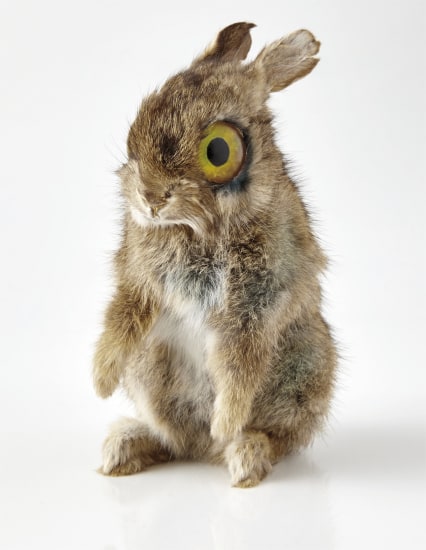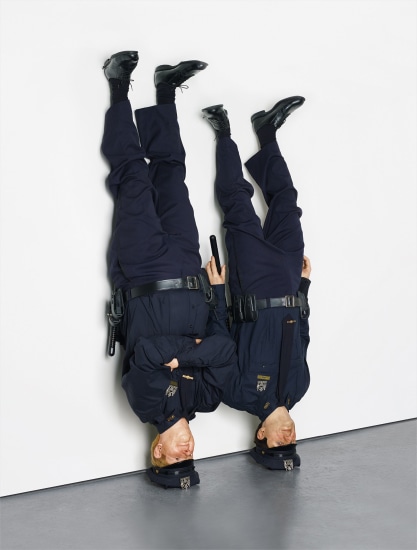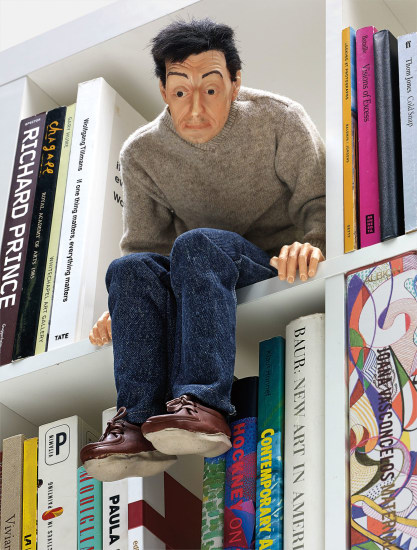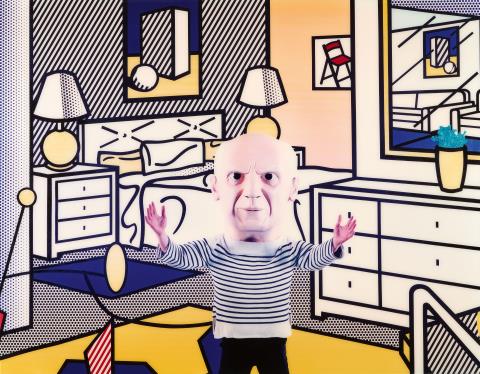Maurizio Cattelan Una Domenica a Rivara (A Sunday in Rivara) 1992 Knotted sheets, wooden coat hanger. Dimensions variable. This work is accompanied by a certificate of authenticity signed by the artist.
Provenance Galleria Massimo de Carlao, Milan Exhibited Castello di Rivara, Centro d’arte contemporanea, Maurizio Cattelan Una Domenica a Rivara, 1992 Literature F. Bonami, N. Spector, B. Vanderlinden and M. Gioni, Maurizio Cattelan New York and London, 2003, p. 98 (illustrated) Catalogue Essay Maurizio Cattelan has been making darkly comic work that has provoked and challenged the nature of the contemporary art world since the late 1980s. A knowing and sophisticated artist, Cattelan has continuously appropriated images and ideas from his everyday life to create a cast of often explicitly self-referential characters and personas who inhabit an absurd world suspended between reality and fiction. Cattelan's flamboyant potpourri of satirical figures – policemen flipped upside down, stuffed animals hanging from the ceiling, a swami who buried himself in sand for hours at a time – serve to simulate and subvert the rules of culture and society in a continuous game of détournement, acts of insubordination and symbolical theft. The idea of robbery has always been at the core of Cattelan's oeuvre with his installations, sculptures and performances nearly always depicting a form of theft in which he is the primary culprit, the main perpetrator of the crime. As an early work from 1992, the present lot, Una Domenica a Rivara (A Sunday in Rivara), is one of his first and most striking statements of his role as an outlaw who challenges the perceived sanctity of art in our society. Created originally for an exhibition at Turin's Castello di Rivara, the physical work itself may simply consist of a number of knotted bed-sheets dangling from the venue's top-floor window like a prop from a movie prison break, yet its conceptual and paradoxical implications are deeply layered in meaning. Una Domenica a Rivara presents Cattelan as an escapologist, a Houdini figure emancipating himself from the art world and its governing institutions – ironically the exact same art world and governing institutions which have established and legitimized the conceptual nature of his work. At once refusing institutional authority while simultaneously embracing it, the present lot perfectly and poignantly encapsulates the inherent Catch-22 nature found throughout all of Cattelan's work. With the dangling knotted sheets as evidence, the formerly incarcerated artist has fled his duty to engage with the art world and create a work of art for the exhibition, leaving behind only a satirical trace of himself as the artwork. Like Marcel Duchamp the original art world prankster, Cattelan has abandoned the traditional production of art altogether and created a work of art which highlights the absurdity of creating a work of art, parodies the veneration and esteem with which art is held in such high cultural institutions. Within his long and acclaimed oeuvre, the early Una Domenica a Rivara can be seen as an antecedent to two other major existentialist works in which Cattelan deals with his place in the history of art by creating works to be exhibited in major institutional spaces loaded with art historical references. In 1997, at the Consortium in Dijon, Cattelan dug a coffin-shaped hole in the floor of the museum's main gallery to acknowledge his own frailty in the face of having to mount a museum show. Tinged with a certain self-mocking cynicism, this act of defeat and mourning was repeated for his memorable 2001 installation at the Museum Boijmans Van Beuningen in Holland in which Cattelan dug a tunnel hacked into the floor of a gallery presenting a collection of 17th-century Dutch masters. Peeking its head above the cavity, a waxwork Cattelan proxy takes a last, lingering look at art he couldn't hope to compete with before escaping. These three masterpieces, with Una Domenica a Rivara as the earliest and most poignant example, powerfully express the innermost fear which inhabits every artist. The fear of not being able to create, of staring at a blank canvas, of not belo
Maurizio Cattelan Una Domenica a Rivara (A Sunday in Rivara) 1992 Knotted sheets, wooden coat hanger. Dimensions variable. This work is accompanied by a certificate of authenticity signed by the artist.
Provenance Galleria Massimo de Carlao, Milan Exhibited Castello di Rivara, Centro d’arte contemporanea, Maurizio Cattelan Una Domenica a Rivara, 1992 Literature F. Bonami, N. Spector, B. Vanderlinden and M. Gioni, Maurizio Cattelan New York and London, 2003, p. 98 (illustrated) Catalogue Essay Maurizio Cattelan has been making darkly comic work that has provoked and challenged the nature of the contemporary art world since the late 1980s. A knowing and sophisticated artist, Cattelan has continuously appropriated images and ideas from his everyday life to create a cast of often explicitly self-referential characters and personas who inhabit an absurd world suspended between reality and fiction. Cattelan's flamboyant potpourri of satirical figures – policemen flipped upside down, stuffed animals hanging from the ceiling, a swami who buried himself in sand for hours at a time – serve to simulate and subvert the rules of culture and society in a continuous game of détournement, acts of insubordination and symbolical theft. The idea of robbery has always been at the core of Cattelan's oeuvre with his installations, sculptures and performances nearly always depicting a form of theft in which he is the primary culprit, the main perpetrator of the crime. As an early work from 1992, the present lot, Una Domenica a Rivara (A Sunday in Rivara), is one of his first and most striking statements of his role as an outlaw who challenges the perceived sanctity of art in our society. Created originally for an exhibition at Turin's Castello di Rivara, the physical work itself may simply consist of a number of knotted bed-sheets dangling from the venue's top-floor window like a prop from a movie prison break, yet its conceptual and paradoxical implications are deeply layered in meaning. Una Domenica a Rivara presents Cattelan as an escapologist, a Houdini figure emancipating himself from the art world and its governing institutions – ironically the exact same art world and governing institutions which have established and legitimized the conceptual nature of his work. At once refusing institutional authority while simultaneously embracing it, the present lot perfectly and poignantly encapsulates the inherent Catch-22 nature found throughout all of Cattelan's work. With the dangling knotted sheets as evidence, the formerly incarcerated artist has fled his duty to engage with the art world and create a work of art for the exhibition, leaving behind only a satirical trace of himself as the artwork. Like Marcel Duchamp the original art world prankster, Cattelan has abandoned the traditional production of art altogether and created a work of art which highlights the absurdity of creating a work of art, parodies the veneration and esteem with which art is held in such high cultural institutions. Within his long and acclaimed oeuvre, the early Una Domenica a Rivara can be seen as an antecedent to two other major existentialist works in which Cattelan deals with his place in the history of art by creating works to be exhibited in major institutional spaces loaded with art historical references. In 1997, at the Consortium in Dijon, Cattelan dug a coffin-shaped hole in the floor of the museum's main gallery to acknowledge his own frailty in the face of having to mount a museum show. Tinged with a certain self-mocking cynicism, this act of defeat and mourning was repeated for his memorable 2001 installation at the Museum Boijmans Van Beuningen in Holland in which Cattelan dug a tunnel hacked into the floor of a gallery presenting a collection of 17th-century Dutch masters. Peeking its head above the cavity, a waxwork Cattelan proxy takes a last, lingering look at art he couldn't hope to compete with before escaping. These three masterpieces, with Una Domenica a Rivara as the earliest and most poignant example, powerfully express the innermost fear which inhabits every artist. The fear of not being able to create, of staring at a blank canvas, of not belo










Try LotSearch and its premium features for 7 days - without any costs!
Be notified automatically about new items in upcoming auctions.
Create an alert